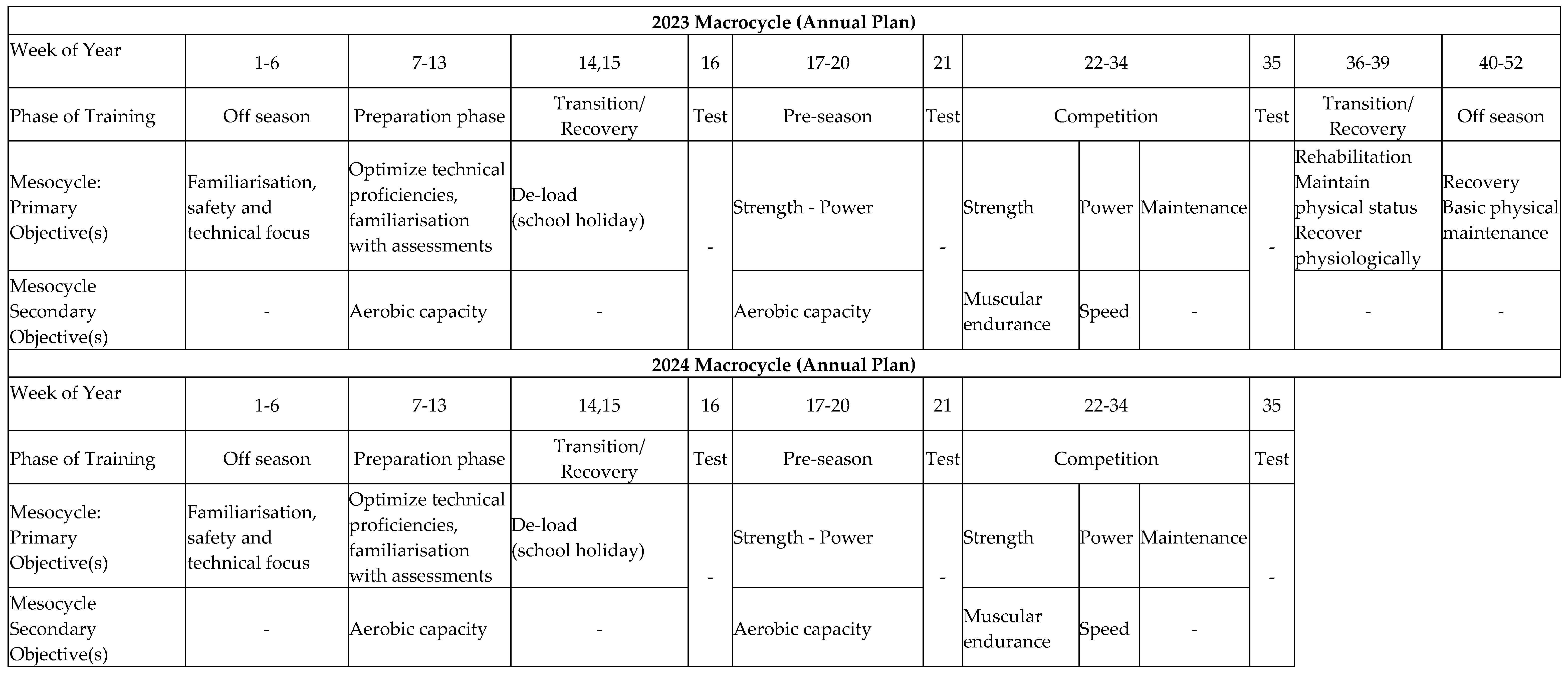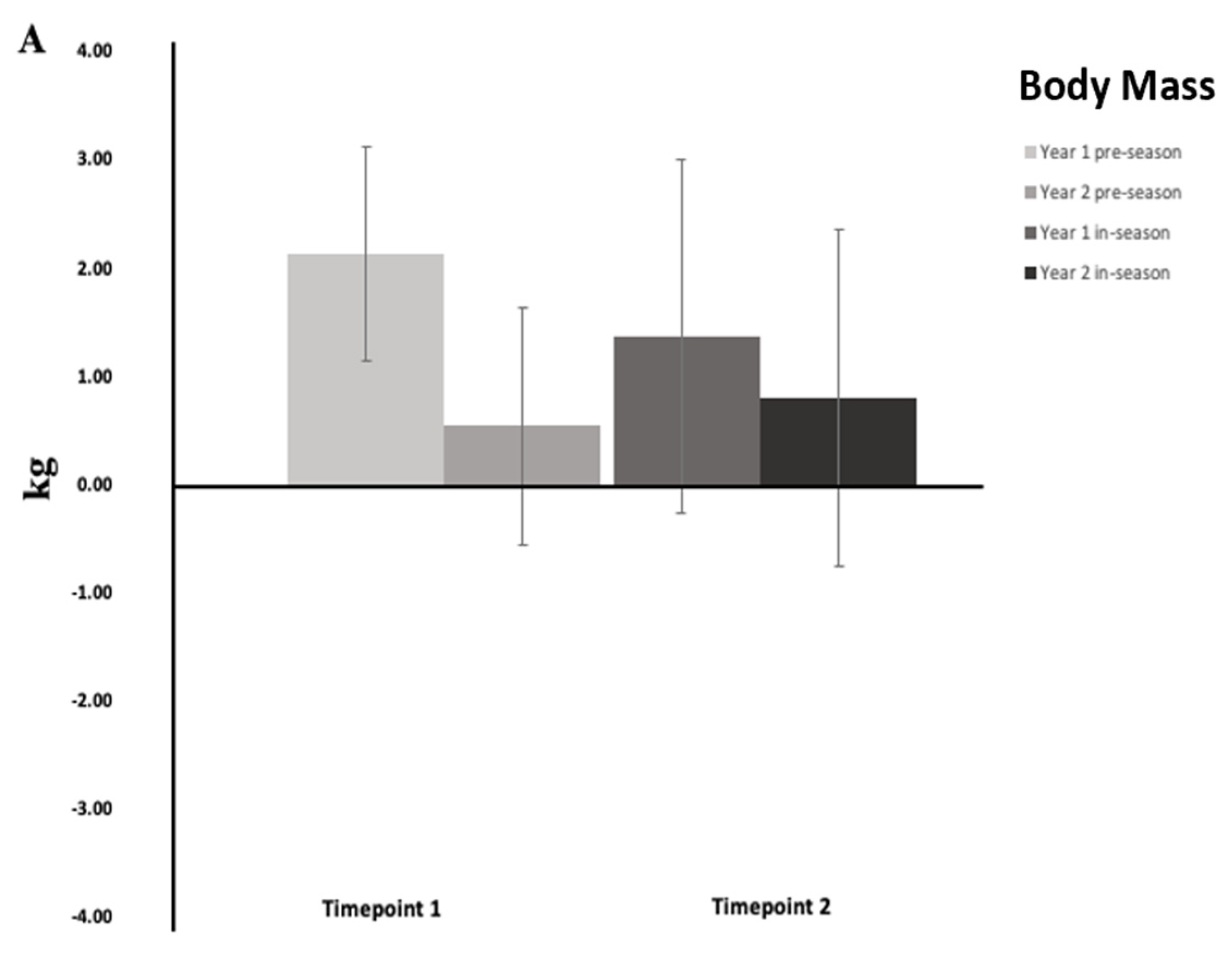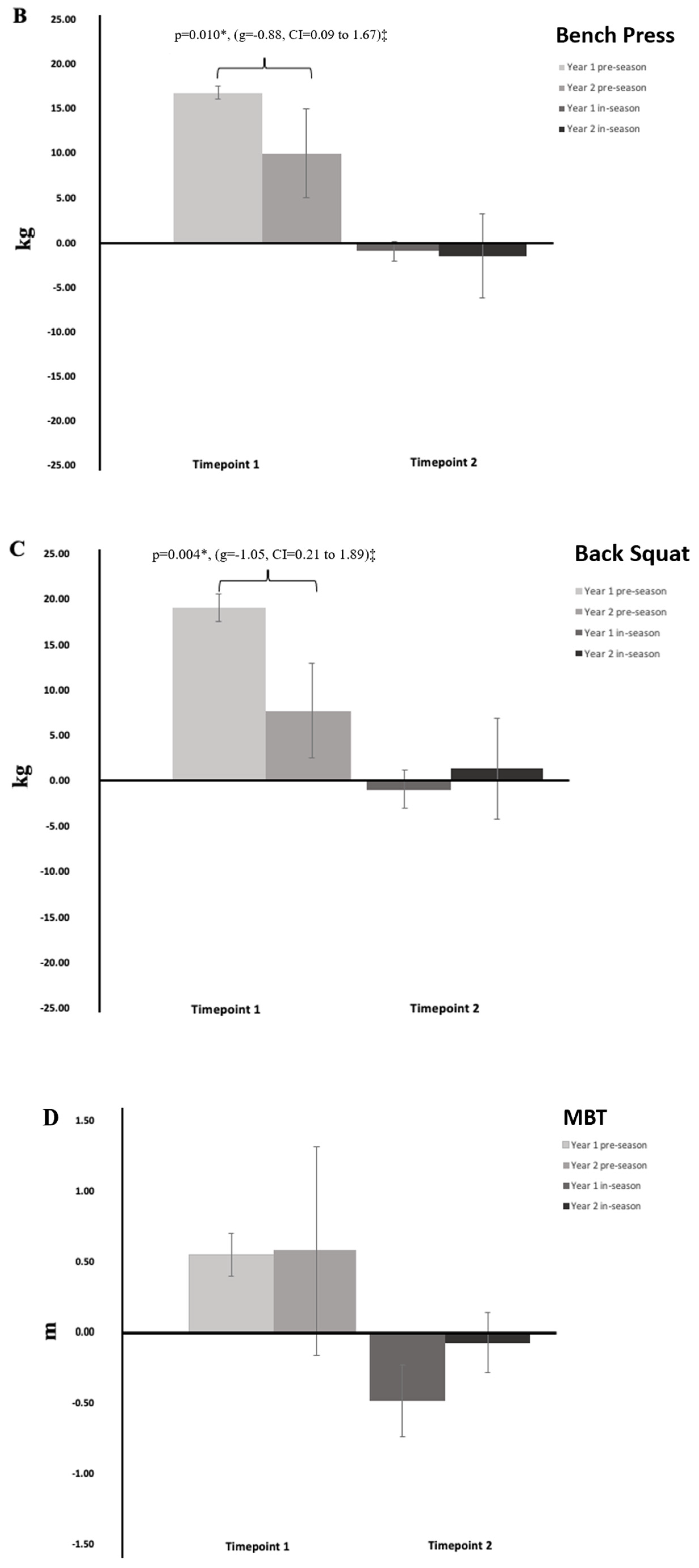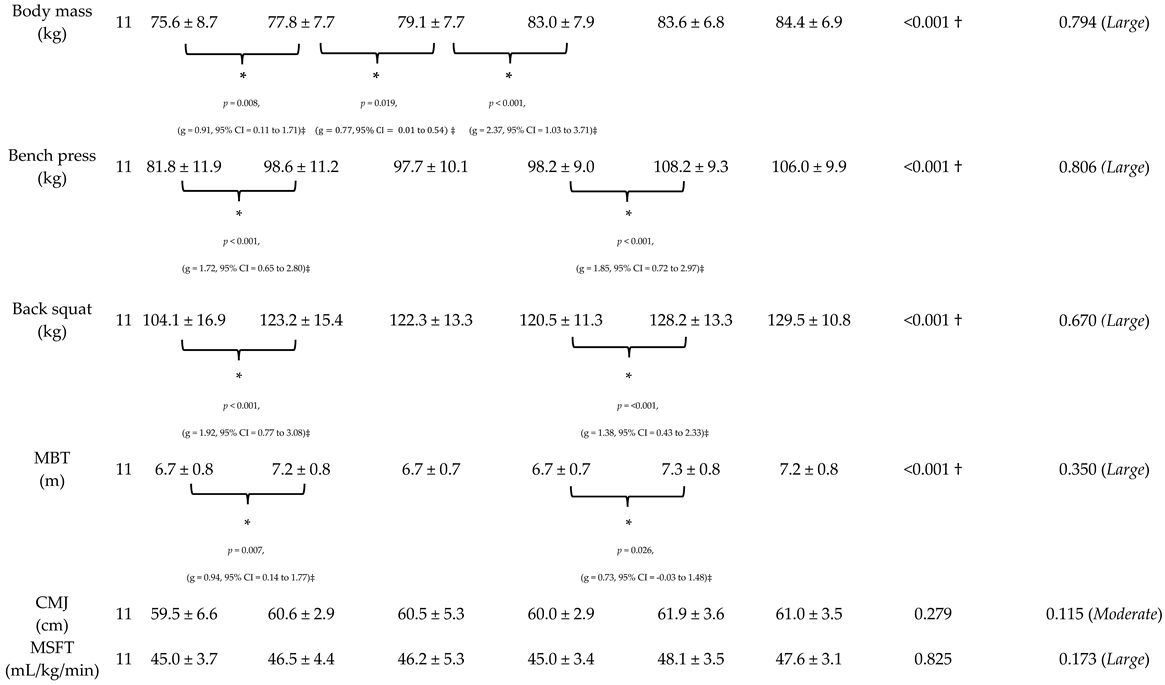Quantifying Long-Term Adaptations in Performance Variables in Adolescent Athletes: A 1.5 Year Longitudinal Training Study Utilising a Standardised, Progressive, Blocked Linear Periodisation Resistance Training Program
Abstract
1. Introduction
2. Methods
2.1. Participants
2.2. On-Field Training Program
2.3. Resistance Training Program
2.4. Two-Year Macrocycle
2.5. Off-Season, Preparation and Transition Phases of Training
2.6. Start of Pre-Season Testing and Pre-Season Phase
2.7. End of Pre-Season Testing
2.8. In-Season Phase
2.9. End-of-Season Testing and Off-Season
2.10. Testing Protocol for Outcome Variables
2.11. Body Mass
2.12. One-Repetition-Maximum Barbell Bench Press
2.13. One-Repetition-Maximum Barbell Back Squat
2.14. Medicine Ball Throw
2.15. Counter-Movement Jump
2.16. Multi-Stage Fitness Test
3. Statistical Analysis
4. Results
4.1. Phase One: Athlete Progression over the First 1.5 Years of Resistance Training
4.2. Phase Two: Comparison of the Relative Change That Occurs During the First and Second Year of Resistance Training
5. Discussion
5.1. Body Mass
5.2. Maximal Muscular Strength
5.3. Maximal Muscular Power
6. Limitations
7. Conclusions
- Key points
- Diminished returns occur in adolescents (16 ± 0.5 years) following a standardised, progressive, blocked linear periodisation resistance training program within their first 1.5 years of training.
- The majority of physiological adaptations in body mass (84%) and strength (1RM bench press: 68%, back squat: 65%) occurred during the first 12 months of training.
- Improvements in strength adaptations were lower by −0.88 (95% CI = −1.67 to −0.09) and −1.05 (95% CI = −1.89 to −0.21) standard deviations for the 1RM bench press and back squat, respectively, from the start of pre-season to end of pre-season in the second year of training compared to the first year of training.
Author Contributions
Funding
Institutional Review Board Statement
Informed Consent Statement
Data Availability Statement
Conflicts of Interest
References
- Shurley, J.P.; Todd, J.S. “The strength of Nebraska”: Boyd Epley, Husker Power, and the formation of the strength coaching profession. J. Strength Cond. Res. 2012, 26, 3177–3188. [Google Scholar] [CrossRef] [PubMed]
- Faigenbaum, A.D.; Myer, G.D. Resistance training among young athletes: Safety, efficacy and injury prevention effects. Br. J. Sports Med. 2010, 44, 56–63. [Google Scholar] [CrossRef] [PubMed]
- Lorez, D.; Morrison, S. Current concepts in periodization of strength and conditioning for the sports physical therapist. Int. J. Sports Phys. Ther. 2015, 10, 734–747. [Google Scholar]
- Zachary, M.T. Impact of resistance training on sports performance and muscular adaptations. Int. J. Sports Exerc. Med. 2022, 8, 218. [Google Scholar] [CrossRef]
- Gentil, P.; Fisher, J.; Steele, J. A review of the acute effects and long-term adaptations of single- and multi-joint exercises during. Sports Med. 2017, 47, 843–855. [Google Scholar] [CrossRef]
- Behringer, M.; Vom Heede, A.; Matthews, M.; Mester, J. Effects of strength training on motor performance skills in children and adolescents: A meta-analysis. Pediatr. Exerc. Sci. 2011, 23, 186–206. [Google Scholar] [CrossRef]
- Harries, S.K.; Lubans, D.R.; Callister, R. Resistance training to improve power and sports performance in adolescent athletes: A systematic review and meta-analysis. J. Sci. Med. Sport 2012, 15, 532–540. [Google Scholar] [CrossRef]
- Latella, C.; Teo, W.P.; Spathis, J.; van den Hoek, D. Long-Term strength adaptation: A 15-year analysis of powerlifting athletes. J. Strength Cond. Res. 2020, 34, 2412–2418. [Google Scholar] [CrossRef]
- Verkhoshansky, Y.; Siff, M. Supertraining, 6th ed.; Expanded Version; Verkhoshansky.com: Rome, Italy, 2009. [Google Scholar]
- Baker, D.G.; Newton, R.U. Adaptations in upper-body maximal strength and power output resulting from long-term resistance training in experienced strength-power athletes. J. Strength Cond. Res. 2006, 20, 541–546. [Google Scholar]
- Baker, D.G. 10-year changes in upper body strength and power in elite professional rugby league players--the effect of training age, stage, and content. J. Strength Cond. Res. 2013, 27, 285–292. [Google Scholar] [CrossRef]
- Appleby, B.; Newton, R.U.; Cormie, P. Changes in strength over a 2-year period in professional rugby union players. J. Strength Cond. Res. 2012, 26, 2538–2546. [Google Scholar] [CrossRef] [PubMed]
- Carron, M.A.; Scanlan, A.T.; Power, C.J.; Doering, T.M. What tests are used to assess the physical qualities of male, adolescent rugby league players? a systematic review of testing protocols and reported data across adolescent age groups. Sports Med. Open 2023, 9, 106. [Google Scholar] [CrossRef] [PubMed]
- Carron, M.A.; Scanlan, A.T.; Doering, T.M. The retest reliability of common tests to assess physical qualities in adolescent rugby league players. Pediatr. Exerc. Sci. 2024, 1, 1–8. [Google Scholar] [CrossRef]
- Carron, M.A.; Scanlan, A.T.; Doering, T.M. Quantifying the training loads and corresponding changes in physical qualities among adolescent, schoolboy rugby league players. Sports 2024, 12, 251. [Google Scholar] [CrossRef]
- Gabbett, T.; Kelly, J.; Sheppard, J. Speed, change of direction speed, and reactive agility of rugby league players. J. Strength Cond. Res. 2008, 22, 174–181. [Google Scholar] [CrossRef]
- Miller, T. NSCA’s Guide to Tests and Assessments; Human Kinetics Publishing: Champaigne, IL, USA, 2012. [Google Scholar]
- Ramsbottom, R.; Brewer, J.; Williams, C. A progressive shuttle run test to estimate maximal oxygen uptake. Br. J. Sports Med. 1988, 22, 141–144. [Google Scholar] [CrossRef]
- Richardson, J.T.E. Eta squared and partial eta squared as measures of effect size in educational research. Educ. Res. Rev. 2011, 6, 135–147. [Google Scholar] [CrossRef]
- Cohen, J. Statistical Power Analysis for the Behavioral Sciences, 2nd ed.; Routledge: Oxfordshire, UK, 1988. [Google Scholar]
- Beyer, W.H. Handbook of Tables for Probability and Statistics, 2nd ed.; e-Book; CRC Press: Boca Raton, FL, USA, 2019. [Google Scholar]
- McIntosh, M.C.; Sexton, C.L.; Godwin, J.S.; Ruple, B.A.; Michel, J.M.; Plotkin, D.L.; Ziegenfuss, T.N.; Lopez, H.L.; Smith, R.; Dwaraka, V.B.; et al. Different resistance exercise loading paradigms similarly affect skeletal muscle gene expression patterns of myostatin-related targets and mtorc1 signaling markers. Cells 2023, 12, 898. [Google Scholar] [CrossRef]
- Roberts, M.D.; Dalbo, V.J.; Hassell, S.E.; Kerksick, C.M. The expression of androgen-regulated genes before and after a resistance exercise bout in younger and older men. J. Strength Cond. Res. 2009, 23, 1060–1067. [Google Scholar] [CrossRef]
- Dalbo, V.J.; Roberts, M.D.; Sunderland, K.L.; Poole, C.N.; Stout, J.R.; Beck, T.W.; Bemben, M.; Kerksick, C.M. Acute loading and aging effects on myostatin pathway biomarkers in human skeletal muscle after three sequential bouts of resistance exercise. J. Gerontol. A Biol. Sci. Med. Sci. 2011, 66, 855–865. [Google Scholar] [CrossRef]
- DeFreitas, J.M.; Beck, T.W.; Stock, M.S.; Dillon, M.A.; Kasishke, P.R., II. An examination of the time course of training-induced skeletal muscle hypertrophy. Eur. J. Appl. Physiol. 2011, 111, 2785–2790. [Google Scholar] [CrossRef] [PubMed]
- Waldron, M.; Worsfold, P.; Twist, C.; Lamb, K. Changes in anthropometry and performance, and their interrelationships, across three seasons in elite youth rugby league players. J. Strength Cond. Res. 2014, 28, 3128–3136. [Google Scholar] [CrossRef] [PubMed]
- Till, K.; Jones, B.; Emmonds, S.; Tester, E.; Fahey, J.; Cooke, C. Seasonal changes in anthropometric and physical characteristics within English academy rugby league players. J. Strength Cond. Res. 2014, 28, 2689–2696. [Google Scholar] [CrossRef]
- Trezise, J.; Blazevich, A.J. Anatomical and neuromuscular determinants of strength change in previously untrained men following heavy strength training. Front. Physiol. 2019, 10, 1001. [Google Scholar] [CrossRef]
- Maden-Wilkinson, T.M.; Balshaw, T.G.; Massey, G.J.; Folland, J.P. What makes long-term resistance-trained individuals so strong? A comparison of skeletal muscle morphology, architecture, and joint mechanics. J. Appl. Physiol. 2020, 128, 1000–1011. [Google Scholar] [CrossRef]
- Redman, K. Seasonal changes in strength and power in elite rugby league: A systematic review and meta-analysis. Br. J. Sports Med. 2015, 49, 14–19. [Google Scholar] [CrossRef]
- Shreffler, J.; Huecker, M.R. Type I and Type II errors and statistical power. In StatPearls (Internet); StatPearls Publishing: Treasure Island, FL, USA, 2023. [Google Scholar]




| Upper-Body | Lower-Body | Full-Body | Plyometrics | Trunk | ||||||
|---|---|---|---|---|---|---|---|---|---|---|
| Classification | Overhead | Anterior | Posterior | Anterior | Posterior | Hip/Glute | Upper-Body | Lower-Body | ||
| Primary | ||||||||||
| Push Jerk | BB Bench Press | BB Bent Over Rows | Front Squat | Trap Bar Deadlift | Hip Thrust | Clean | ||||
| DB Push Press | BB Incline Bench Press | Seated Row | Back Squat | Romanian Deadlift | Power Clean | |||||
| BB Push Press | BB Decline Bench Press | DB Rows | Overhead Squat | Hang Clean | ||||||
| BB Overhead | Full Clean | |||||||||
| Secondary | ||||||||||
| Seated DB Overhead Press | DB Bench | Chest Supported Rows | SL Deadlift | Hip Hinge | Clean Pull | Clap Push-up | Alternating Bounds | Sit-ups | ||
| Standing DB Overhead | Incline Bench | Landmine row | Box Squat | DB Deadlift | Back Elevated Hip Up | Clean Shrug | Med Ball Chest Pass | Tuck Jumps | Barbell Rollouts | |
| DB Cuban Press | Incline DB Bench | BB Inverted Row | Overhead Squat | Band Deadlift | SL Hip Ups | DB Cleans | MB OH Forward Pass | Copenhagen | ||
| Neutral Grip DB Overhead | Dips | Band Rows | Goblet Squat | Below Knee Rack Pull | Band Hip Extensions | KB Cleans | Wall Ball | Broad Jumps | Hanging Leg Raises | |
| Y-raise, W-raise, T-raise | Band Bench | Straight Arm Pulldown | Hack squat | Above Knee Rack Pull | Hip Adduction | Famers Walk | Med Ball Rotational Throws | Depth Drops | Cable Chop | |
| Side Delt Raises | Push-ups | Reverse Fly | High Box Squat | SL DB Romanian Deadlift | Hip Abduction | Med Ball Ground Slam | Depth Jumps w/ Bound | Band Rotation Fend | ||
| Rear Delt Raises | Elevated Push-ups | Pullups | Deep Box Squat | DB Romanian Deadlift | Hip Flexion | Lying Medball Chest Pass | Hurdle Hops | |||
| Face Pulls | Foot Elevated Push-ups | Lat Pulldowns | Band Squat | Reverse Hypers | Lateral Bounds | Planks | ||||
| Internal and external Shoulder Rotations | DB Flies | Band Pulldowns | Body weight Squat | Landmine Romanian Deadlift | SL Box Jumps | 3 Way Plank | ||||
| DB Incline Flies | Chin-ups | 5 second Pause Squat | Band Leg Curls | Lateral Bounds | Russian Twists | |||||
| Band Push-ups | Inverted Row | Nordic Hamstring Curls | Seated Jump | V-shape Sit-ups | ||||||
| DB Push-ups | Band Good Morning | Vertical Jumps | Toes to Bar | |||||||
| Sled Pull | Calf Hops | SA Farmer Walk | ||||||||
| Sled Push | Split Squat Jump | |||||||||
| BB Lunges | MB Rotational Throws | |||||||||
| Walking DB Lunges | KB Swings | |||||||||
| Walking BB Lunges | SL Vertical Jump | |||||||||
| SL Box Squat | Split Squat Jumps | |||||||||
| SL Squat | ||||||||||
| SL Hip Lift | SL Hurdle Jumps | |||||||||
| Lateral Lunges | ||||||||||
| DB Split Squat | ||||||||||
| DB Step Up | ||||||||||
| BB Step Up | ||||||||||
| Power Step Up | ||||||||||
| Leg Extension | ||||||||||
| Test | N | Pre-Season | End Pre-Season | End Season | Pre-Season | End Pre-Season | End Season | Sig (ANOVA) | Partial ETA-Squared (n2p) |
|---|---|---|---|---|---|---|---|---|---|
 | |||||||||
Disclaimer/Publisher’s Note: The statements, opinions and data contained in all publications are solely those of the individual author(s) and contributor(s) and not of MDPI and/or the editor(s). MDPI and/or the editor(s) disclaim responsibility for any injury to people or property resulting from any ideas, methods, instructions or products referred to in the content. |
© 2025 by the authors. Licensee MDPI, Basel, Switzerland. This article is an open access article distributed under the terms and conditions of the Creative Commons Attribution (CC BY) license (https://creativecommons.org/licenses/by/4.0/).
Share and Cite
Carron, M.A.; Dalbo, V.J. Quantifying Long-Term Adaptations in Performance Variables in Adolescent Athletes: A 1.5 Year Longitudinal Training Study Utilising a Standardised, Progressive, Blocked Linear Periodisation Resistance Training Program. Sports 2025, 13, 164. https://doi.org/10.3390/sports13060164
Carron MA, Dalbo VJ. Quantifying Long-Term Adaptations in Performance Variables in Adolescent Athletes: A 1.5 Year Longitudinal Training Study Utilising a Standardised, Progressive, Blocked Linear Periodisation Resistance Training Program. Sports. 2025; 13(6):164. https://doi.org/10.3390/sports13060164
Chicago/Turabian StyleCarron, Michael A., and Vincent J. Dalbo. 2025. "Quantifying Long-Term Adaptations in Performance Variables in Adolescent Athletes: A 1.5 Year Longitudinal Training Study Utilising a Standardised, Progressive, Blocked Linear Periodisation Resistance Training Program" Sports 13, no. 6: 164. https://doi.org/10.3390/sports13060164
APA StyleCarron, M. A., & Dalbo, V. J. (2025). Quantifying Long-Term Adaptations in Performance Variables in Adolescent Athletes: A 1.5 Year Longitudinal Training Study Utilising a Standardised, Progressive, Blocked Linear Periodisation Resistance Training Program. Sports, 13(6), 164. https://doi.org/10.3390/sports13060164







